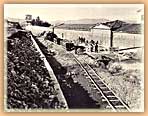 |

After the almost ten-year War of Independence and the conflicts that came after the assassination of Kapodistrias, the Greek economy was all but totally destroyed. Agricultural production was at a very low point, while trade and maritime activities were practically at a standstill. This was the state of affairs the Regency had to face when it came into power. Its main choices both with regard to the question of land ownership as well as to that of state finances had to do with the effort to revive economic activities, to rationalize the fiscal system and generally to create a modern Western-type state. The first major wave of growth came in the 1860s and 1870s. After the crisis of the Crimean War - when the impasses to which an irredentist policy had led the country became apparent - priorities shifted towards economic development. Several factors contributed to a climate that helped attract foreign investment into Greece. One of the most important was the international recession which escalated in 1873, and led to a drop in interest rates abroad. From 1878 on, with the settlement of foreign debts contracted in the past and the comparatively higher interest rates Greece offered in relation to those of the European money markets, there was a rise in capital flowing into Greece from the West in the form of foreign loans, a trend that was at that time observed in other countries on the periphery as well. At the same time, the Agrarian Reform of 1871 was one of the most important domestic changes. The smallholdings it created promoted intensive cultivation of things like the Corinthian currant. The increase in currant exports accelerated the upward course of the economy. Alexandros Koumoundouros marked these two decades. His work became the starting point for Charilaos Trikoupis, the politician who dominated the political stage during the last quarter of the century. He implemented an investment programme that aimed at the construction of large infrastructure works. These works were mainly financed through foreign loans, which in the 1880s were easy to raise. At the beginning of the 1890s, however, it became clear that the country's borrowing capacity had been exhausted, a fact which led to the bankruptcy of 1893. One thing that has to be pointed out is that the policy of Trikoupis was aimed at modernizing the Greek economy, in other words, bringing it into line with the rates of economic development in the Western world, by adopting the economic model used in England. His plan moreover did not focus only on economic matters but equally on the reorganization of the state and the political system. And it is in the light of these objectives that the precarious practice of over-borrowing has to be viewed.
|
 |